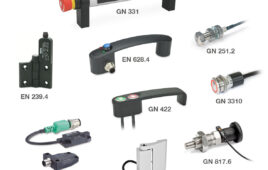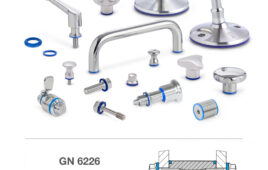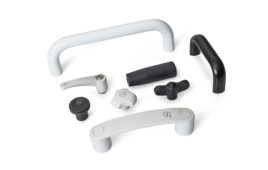By Dr. Jody Muelaner
Levers are available as extended handles, typically with a threaded shaft or hole at one end to enable fastening to a machine. They are used to increase mechanical advantage, allowing hand operation to exert considerable force, often in conjunction with a screw which multiplies the mechanical advantage.

Levers are used on machines to turn screws and clamps for position adjustments or clamping. Two types of standard levers available for machine building: a lever arm (left) and clamping handle (right).
In classical mechanics, a lever is a beam that pivots about a fulcrum to apply a load when effort is applied. The fulcrum, load, and effort must all act at different points along the length of the beam for it to function as a lever. If the load is applied closer to the fulcrum than the effort, the lever provides mechanical advantage, or simply leverage.
However, in common use, the closely spaced couple of forces, made up of the fulcrum and load, may not be considered as part of the lever. Instead it is common to consider only the long beam extending from the couple as the lever. For example, the jaws of a spanner exert a couple of forces on the head of a bolt, the handle, which extends from the jaws would be considered the lever.
Some levers available as standard components for machine building include:
• Lever arm: A straight bar with a threaded shaft or hole at one end and a rounded handle at the other, all arranged along a single axis.
• Clamping lever: A small assembly consisting of a machine screw with a captive handle that fits over its head and protrudes perpendicular to the screw. This effectively acts as a screw with a permanently attached spanner. The head of the screw typically has a serrated section, a plane shaft and a tapped hole in the top. The tapped hole is used to fit a smaller retaining screw to keep the handle in place. The handle is able to slide axially along the head, either engaging with the serrations to tighten the screw or moving freely around the plain shaft. This allows the screw to be tightened within a confined space.
• Ratchet handles: Similar to clamping levers but with a ratchet mechanism so that tightening by backwards and forward motion can be carried out without having to manually slide the handle up and down the head of the screw.
• Crank handles: Similar to the handle part of a clamping lever, without the screw. They usually have a square hole which allows them to be fitted to easily machined screw heads made for specific machines, or standard clamping screws which can carry high torque.





Tell Us What You Think!